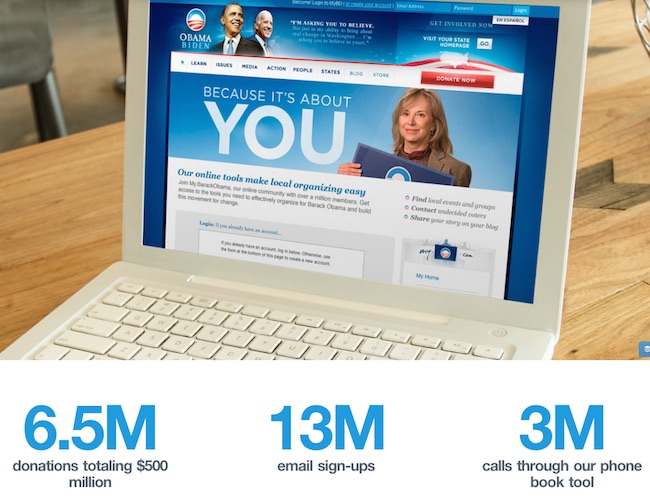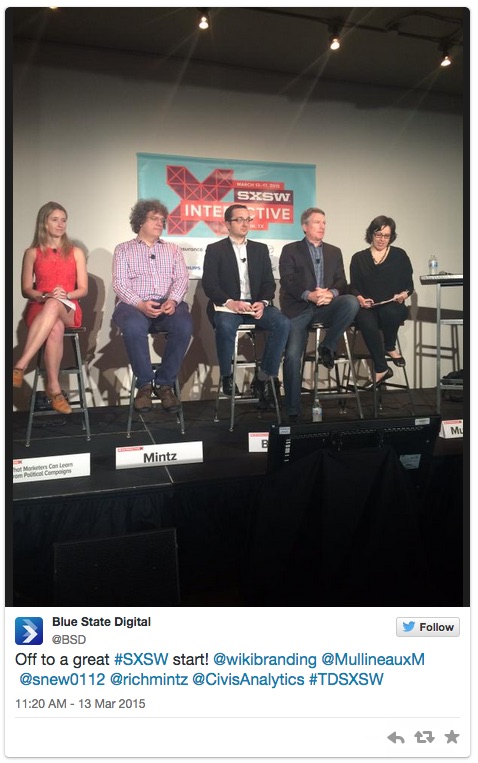
On my first day at SXSW, I attended “What Marketers Can Learn From Political Campaigns”.
I was thrilled to hear Rich Mintz talk again – I first met Rich at Notre Dame when he came to speak with us about Obama’s 2008 presidential campaign. Rich went over how they used their digital programs to build a very energized and active community of advocates in a short period of time and then used this community to get the president elected.
Now I don’t know where you fall in politics and frankly I really don’t care. You can check out my social media posts if you want but I never really discuss politics. To me, we get it from both parties way too much but that’s about as far I get with politics.
When it comes to how a campaign community was built and then used to activate people – I’m all in. And Blue State Digital is one of the best at doing this.
Here’s what they said the panel would be about and they didn’t disappoint.
“From the emergence of mass media via Television, political campaigns have used the medium with great effect to build belief in their candidates. From Eisenhower’s patriotic “I like Ike” campaign, to LBJ’s “Daisy Girl” commercial, campaigns used the broad appeal of television to create belief.
Today, technology has democratized conversations and put power into the hands of real people—emphasis on real.
What can Madison Avenue learn from this transformation?
In this panel, we’ll discuss how brands and marketers can adopt the road-tested tactics of successful political campaigns, including smart data segmentation, rapid response, emotional storytelling, and influencer engagement. By moving supporters up the ladder of engagement and asking them to take more and more meaningful actions on behalf of the things they care about, brands can create a community of advocates prepared to act on their behalf anytime, anywhere.
Presented By Team Detroit.”
Here’s who was on the panel. You should definitely think about following these smart people.
David Murphy – President Team Detroit
Michelle Mullineaux – VP of Marketing, Blue State Digital
Peter Bouchard – Director of Media, Civis Analytics
Rich Mintz – Executive VP, Blue State Digital
Here are my key takeaways from the panel that could help the dairy industry as it works to build advocates via their farmers, industry professionals and our wonderful customers.
1. You need to have the big data captured with the proper tools then turned into smart data to be able to adjust with the speed of campaign.
In order words, you need to make sure you have the proper infrastructure in place. Customer Relationship Management (CRM), Email, Social Media, Advocacy specific tools all connected together then tie this to your listening and analytics tools so the big data turns into smart data.
This is a big change for the industry who has traditionally allowed other partners within the industry (mainly retailers and some processors) to have those trusted relationships with customers. We need to be connecting directly and engaging as well.
Because with data today, everything is knowable and the data and analytics of it can create a culture of curiosity in an organization.
2. SPEED and OPPORTUNITY are everything to a campaign.
This is not a 9-5 job. Much like our dairy farmers, it’s 24/7 and when things happen you need to take advantage of trends and opportunities.
Do they wait for the lawyers and executives to approve emails going out the door? Sure but they have the lawyers and executives on call just like everyone else to get things out the door as quickly as possible.
The culture is nimble and always on and can turn on a dime.
This was also a point made by Chevy during the Advocates vs. Agitators session. You’ll get my notes in another blog post.
So if you need to turn on a dime, then your entire organization needs to understand your mission and vision. The mission and vision need to be the pillars of your org’s foundation. It’s crucial when you have to act fast. Confusing or vague mission and vision statements cause more damage than good.
3. Social media is more powerful than advertising but advertising is great at mobilizing people and creating awareness.
You can’t have one or the other. Everything works together – you need advertising for awareness and driving people to get into the advocacy system. But once they are in, you can rely on social media to drive action within and outside the group. But you have to be careful with this because…
People put their reputation on the line when they speak up for you. Use it wisely.
I wish I could emphasize this more. When people push your messaging in their network, they are vouching for you. They are wearing your messaging like a logo’d t-shirt. Except it can be permanent like a tattoo and haunt them forever so you better make sure your messaging is relevant and smart.
4. What’s relevant and smart messaging? Authentic storytelling.
Storytelling is such a buzzword right now – and kinda always has been.
The difference with storytelling on the web is that you can build a story with text, videos, pics and then even interaction whether via social or not. It has more bells and whistles then you can shake a stick at but it always comes back to the story.
If the story isn’t believable then the audience will know you are lying (how fast will they know – a person’s gut can tell a lie in 5 milliseconds). If it’s not passion, they’ll flatline. If it’s not interesting, they’ll be bored.
How do you fix all of these things with your story? Work on it. Revise it. Rework it.
Keep telling the story and notice how people are reacting. When you tell it, do they fake interest? When you wrote it online, does it have a big bounce rate? Low video views?
Storytelling is an art and science and we are hardwired to understand things in the terms of story – not data. Practice doesn’t make perfect but it will help you to learn the secrets of telling a good story.
And how did they work the story with in the political campaign?
5. They tested non-stop. No test too small or too large. Everything got tested. Long emails, short emails, headlines, body copy, call to actions, tone, color, etc…
Everything was under the scope. Why?
Because (and this was huge to me) they were wrong 50% of the time. 50 PERCENT! I guess it’s better than more major league baseball players but I definitely don’t want me my doctor batting .500.
Anyway, they loved that they were wrong 50% of the time because the data doesn’t tell you what to do – it just makes them knowable. It demands you ask better questions from your data and your audience vs. what you are currently doing.
6. When it came to messaging overall – positive stories always outlasted and outgunned the negative ones.
They would only spin things toward negative if they felt like they needed a course correction on misinformation from the opposite side. Which, unfortunately, is a lot today in current politics.
The last thing they emphasized was having a goal – even if it’s a made up goal.
7. You will keep your advocates engaged if they are standing up for something that you both believe in but there is also a goal in sight.
When you reach one goal, make another and another. Don’t just have a perpetual campaign running because everyone gets bored. Even your most loyal supporters. Work toward a goal together and your advocates will turn into teams, which turn into armies of support. Without goals, things just fade over time.
So to sum up the key takeaways:
Capture the data and turn it into smart data you can use.
If there is an opportunity to engage, don’t wait – you need a nimble team that can react quickly to take advantage.
Social media can amplify your messages – much more powerful than advertising.
Don’t abuse your advocates by not putting messages into good stories.
Test everything because you aren’t as smart as you think you are.
Positive stories will outshine negative spin every time.
You need a goal for your advocates to reach and celebrate.
Not too bad for the first session on my first day at SXSW.

Leave a Reply